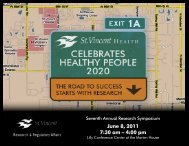Making Data Talk: A Workbook - National Cancer Institute
Making Data Talk: A Workbook - National Cancer Institute
Making Data Talk: A Workbook - National Cancer Institute
- No tags were found...
Create successful ePaper yourself
Turn your PDF publications into a flip-book with our unique Google optimized e-Paper software.
Some other things to consider◆ <strong>Data</strong> should be used sparingly to limit cognitive burden and presented in formats that are familiarto the audience (e.g., pie charts).◆ Framing messages as gains/benefits or losses/negative effects can be highly influential. For primaryprevention, emphasize the positive effect of the behavior; for secondary prevention (e.g., screening),emphasize the negative consequence of failing to be screened.◆ The order or sequence of data will impact how information is remembered. For example, the firstand last numbers presented are most likely to be remembered. 22◆ Identify and make numbers ‘stand out’ by showing how they are unique or novel. Doing sowill help demand attention and can promote newsworthiness.◆ Integrate words, numbers, and symbols.After reading this chapter, you should have a general understanding that applying the OPT-In frameworkto a communication task can result in presentations that promote audience members’ understanding ofdata. For further detail on concepts presented in this chapter, refer to Chapter 5, Putting it All Together:Communicating <strong>Data</strong> for Public Health Impact, of <strong>Making</strong> <strong>Data</strong> <strong>Talk</strong>: Communicating Public Health <strong>Data</strong> to thePublic, Policy Makers, and the Press.Practice ExerciseThe <strong>National</strong> <strong>Cancer</strong> <strong>Institute</strong> administers the HealthInformation <strong>National</strong> Trends Survey (HINTS), which isa biennal, cross-sectional survey of a nationally-representativesample of American adults that is used to assess the impactof the health information environment. Specifically, HINTSmeasures how people access and use health information,how people use information technology to manage healthand health information, and the degree to which peopleare engaged in healthy behaviors.Use the following exercise as an opportunity to apply theOPT-In framework to a real-world communications task.A portion of a HINTS brief, which provides a snapshotof noteworthy, data-driven research findings, is providedhere. This brief explores factors associated with accurateknowledge about lung cancer and the negative effects oftobacco use through the analysis of HINTS survey data.Read the results outlined in the brief. You want tocommunicate the results to the regional health directorto support development of an educational campaign butare unsure about your messaging, your presentation, and how you will integrate your messagesin a broader context. Use the questions on the next page to help you prepare to communicateyour data. Read the entire brief by visiting: http://hints.cancer.gov/brief_11.aspx.26





